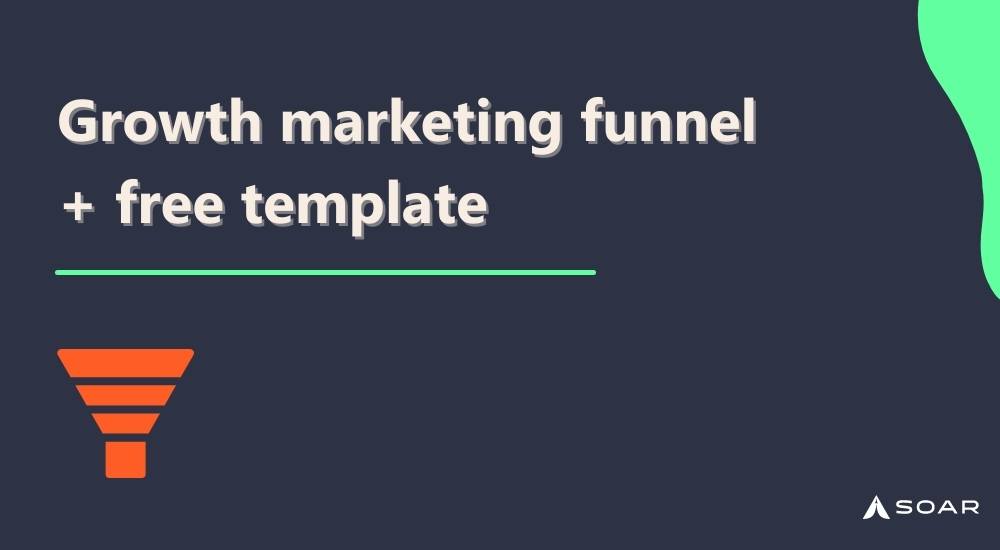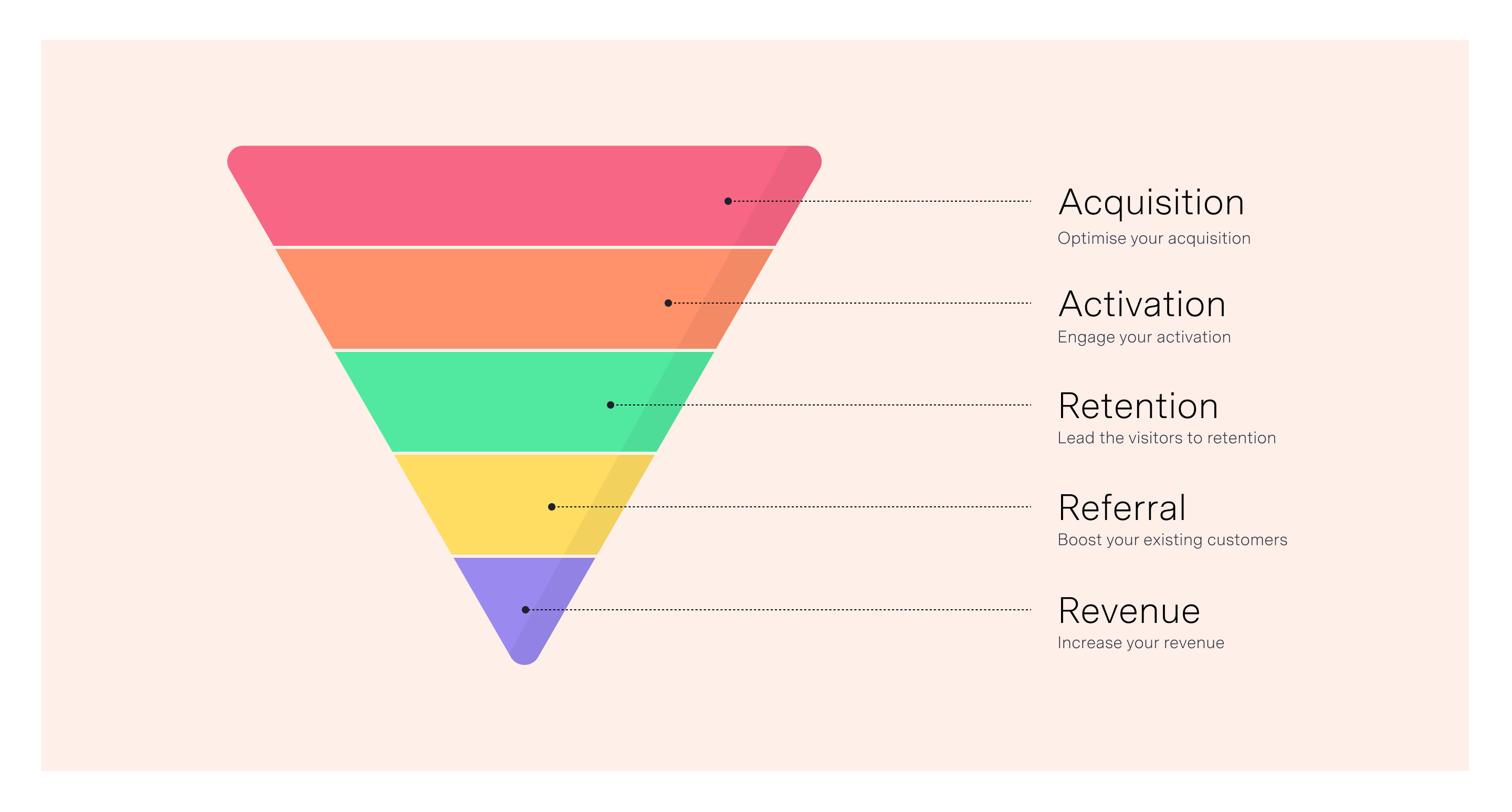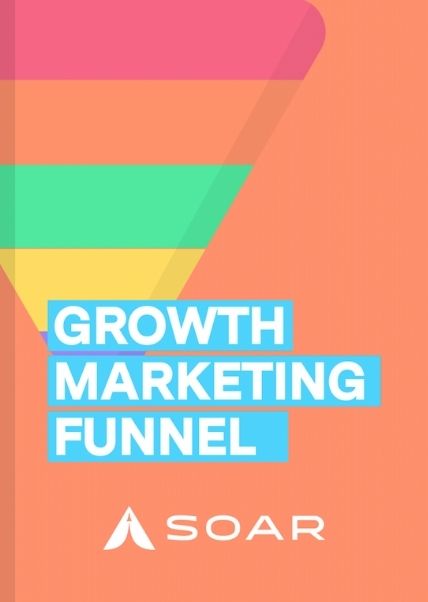Contents
Growth marketing is a fascinating field of marketing. If you’re here, you probably think so too.
But what makes growth marketing so special?
The answer to that is the unique growth marketing funnel that is used by growth marketers.
This funnel is known as the pirate metrics that shows you where your business is losing customers and also reveals how optimizing the marketing and sales funnel can help fix that in an efficient manner.

What is a growth marketing funnel?
The growth marketing funnel, also known as the pirate metric was created by Dave McClure, a serial entrepreneur who co-founded over 500 startups.
He believed that in order to be successful, founders and CEOs should only focus on these 5 key metrics, Acquisition, Activation, Retention, Referral, and Revenue. This is the basis of the pirate metric and this framework is also known as the AARRR funnel.
Today, growth hackers use this growth hacking funnel to identify the weakest point of the customer acquisition cycle, so that they can focus on improving it.
This growth marketing funnel works because it helps brands identify weak spots and work on them to provide a better experience for their customers.
Create a growth marketing funnel using the AARRR framework
Now that you know about the pirate metric, you might be itching to see how you can apply this to your business.
To help you get it right, we have mapped out a step-by-step process and created a free downloadable template to help you create your growth hacking funnel the right way. So, download your copy and let’s dive in!

Step 1: Clearly define the steps
The first thing you must do while setting up your AARRR growth marketing funnel is to define the various steps relevant to your business. What does this mean?
Basically, take some time out to look at your business and make note of all the important steps a person takes when they come in contact with your brand.
For example, signing up for your newsletter or as a user on your website, adding an item to their basket, scheduling a call with your business, etc. Once you have this list ready, assign these actions to different steps in the AARRR model.
Below is our website header navigation, with the main call to action we want our visitors to take.

For example, at the acquisition stage, you can define the number of people visiting your website, at the activation stage, define the number of people who take an action like sign up for your newsletter or schedule a call or make a purchase, and so on.
Keep in mind that each step of the AARRR funnel should be associated with a measurable parameter. Once you have identified a measurable parameter at every stage of the growth funnel, we are ready to move on to the next step.
Step 2: Understand the different metrics in the AARRR funnel and assign your values
To understand each step of the funnel better, let us take the example of a newly launched app. Below we will break down the different metrics of the AARRR marketing funnel in relation to the app to help you understand it better.
Don’t forget to download our free AARRR template to fill out for your business and start the process yourself.
Acquisition: Generate new users
Acquisition is the first stage of the growth funnel and it is essentially the first point of contact between your business and your potential customer.
For a newly launched app, the goal here would be to generate new users for your app. At this stage, you could even break down the acquisition stage into two, new user downloads and new user engagement.
At the acquisition stage, you want to get into details about these new users signing up for your app. Where do they come from, Apple Store or Google Play. Next, you want to break down how they find your app, is it from Google search or from different advertising channels.
This will help you calculate the conversion rate for each channel and make it easier for you to understand the customer acquisition cost.
Now that you know how many users found your app, from those how many of them actually went ahead and downloaded it, next you want to know how many went a step ahead and registered on your app.
Once you’ve analyzed the acquisition stage, your next step is to activate the interest of the registered users by showing them how your app can solve their problems.
Note: Remember to aim for your target audience not just to get any traffic.
Activation: Engage users and keep them interested
Activation is the second stage in the marketing funnel wherein the growth hacker studies the data to understand how many users who registered actually use the app. It is important to understand that not everyone who registers will use the app.
According to the data available, the activation rate for an online business is usually <25%. This is common for most mobile apps and SaaS startups.
So, at this stage, it is the job of a growth hacker to get the user to understand the unique ways the app can be useful to the user and ensure that they are engaged so that they continue to come back and use the app.
A great way to do so is to give the user a quick tutorial explaining all the features of the app and getting them to try it out right there.
Note: Remember to convert your new customers or existing customers into engaged customers.
Retention: Make visitors stick around
As a marketer or a business owner, you know the importance of having an engaged audience. The users who use your app regularly add to your data pool, understand your value proposition, and are more likely to recommend your app to their friends and family.
During this stage of the growth hacking funnel, the question that arises is how can you get your users to come back and use your product regularly? For mobile apps, the one way you can do so is by using push notifications.
At this stage, what you want to keep track of is the number of users who have opted in for push notifications and the number of users who have opted out. Additionally, from the ones who have opted in, how many of them actually click and get on the app following the notification sent out.
These are important metrics to keep in mind while calculating the retention rate of your product. To calculate the retention rate, you will need to compare the percentage of users who returned on the 1st day after registration and how many returned on the 7th day after.
Note: Remember that in most cases, retaining customers are way more beneficial for business than bringing new customers.
Revenue: Create avenues for income
The next stage is the revenue created from your app. How many people using your app are subscribing to an additional or premium service? Are you meeting your revenue goals? Is your product fit for the audience using the app?
Dive into the data available and see how many users have shown interest, but have not proceeded to make the purchase. All of the relevant data needs to be mentioned in this section of the pirate metrics.
Come up with ideas on how to convert regular customers into paying customers and therefore, increase the customer lifetime value. Consider your growth marketing strategies and sales process and how they can be improved to convert more users into spending more money with you.
Note: Remember to multiple the amount of your revenue streams for a healthy sustainable growth of your business.
Referral: Get your customers to endorse your app
This is the final stage in the pirate metrics framework where the growth hacker looks at the referral scheme developed to boost the growth of the app. At this stage, the goal is to get existing users who find the app valuable to invite their friends and family to download and use the app.
Referral programs are known to drive viral growth. So, under this section, dive in and check the data to see how effective your referral scheme is and if it is driving the desired growth.
Once you’ve filled in all the details in the pirate metrics, the next step is to get to the analysis.
Note: A powerful referral program can be a game changer for your business, so pay attention to that.
Step 3: Find your bottleneck
Now with the AARRR framework all filled up, you will be able to easily analyze the data and look at the big picture. The best way is to look at the percentage that survives from one step to the other in the AARRR framework.
Once you have calculated this data, you can check which percentage is the lowest and that is the bottleneck that will need to be fixed.
Step 4: Dive deeper from problem to cause and find the right solution
Once you have identified the problem, you want to take a closer look to understand why you’re losing customers at that particular stage. To do so, you need to turn to the soft data and observe what people are doing.
You can use a tool like Hotjar for that, or you can send out a survey to understand the issue better. Once you’ve identified the cause of the problem, you can do the following:
- Brainstorm ideas on how to solve the problem
- Rate them based on the ease and potential to problem solve
- Create an experiment to see what works better to solve your problem
- Execute the experiment and collect all possible data
- Study the outcome and react accordingly
And that is how you solve your business problems and work on accelerating growth using the pirate metrics or the growth marketing funnel.
Would you like to get a free growth marketing funnel template? Use the form below to get it.
Start growing your business
The growth marketing funnel template will help you focus on 5 key metrics of your business to convert your challenges into strengths

By submitting your e-mail you agree that Soar will register your email to the marketing database.
Understand your potential customers
As a growth marketer, you need to understand the customer journey, so you can adjust your marketing efforts accordingly. There are many types of marketing funnels out there and you can replicate existing strategy that worked for a company but doesn’t necessarily need to work for you.
That’s why it’s important to have a deep understanding of the customer journey and all different parts of your marketing efforts. Meaning, you need to be on top of your sales teams, customer success team, paid ads team, as well as content marketing strategy.
Conclusion
Growth marketing funnel a.k.a. AARRR pirate metrics is a necessary part of your growth marketing strategy to get more potential customers to your website. Use several different growth marketing strategies to A/B test and run experiments on your website or app.
Learn about how Soar helped hack 18,335 site visits in one day with Reddit using this growth marketing funnel. Schedule a call with our team of growth hackers to help your business achieve the same results today!
Contents